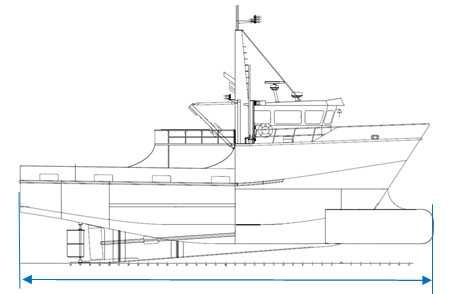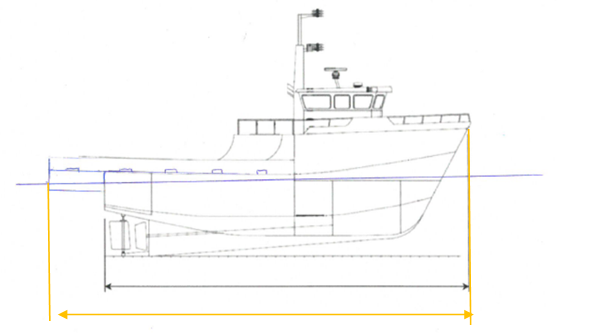RDIMS No .: 18816300
Date (Y-M-D) : 2022-11-03
Scope
This bulletin applies to Canadian fishing vessels that are:
- no more than 24.4 m in length; and
- no more than 150 gross tonnage.
Purpose
This bulletin clarifies the term “hull length” from Part 0.1 section 3.01(1) of the Fishing Vessel Safety Regulations (FVSR).
Background
The correct measurement of ‘’hull length’’ must be used to accurately follow Transport Canada regulations. If the wrong one is used, it could lead to a non-compliance.
A mistake made while calculating the hull length, such as not including a stern extension, will result in obtaining the wrong value of hull length for the vessel.
As the FVSR uses hull length to determine many requirements, such as for safety equipment and stability assessments, using an incorrect hull length may lead to having the incorrect type of safety equipment or procedures for the vessel and decrease its level of safety.
What you need to know
The Fishing Vessel Safety Regulations define “hull length” as:
“hull length, in respect of a fishing vessel, means the distance measured from the forward end of the foremost outside surface of the hull shell to the aft end of the aftermost outside surface of the hull shell.”
You should measure the hull from the very tip of the bow to the very tip of the stern. This measurement should include all parts of the vessel, including things like the hull, bulwarks, and deck extensions.
Figure 1: Hull length measured from the tip of a vessel’s bow to the tip of the stern. (Blue Line)
Figure 2: Hull length measured from the tip of a vessel’s bow to the end of a platform that extends over the vessel’s stern. (Yellow Line)
The measurement must be taken between two vertical planes: one passing through the foremost part of the vessel’s hull and the other through the aftermost part of the vessel’s hull. Hull length includes all structural and integral parts of the vessel, such as bulwarks and hull / deck extensions.
Any extension or component that is integrally formed, molded or welded to the vessel is considered part of the hull shell and is included in the length, even if it doesn’t add to buoyancy. This includes:
- bulbous bow
- stern platform
- swim platform
- attachment structure for the propulsion system
- structural rub rail
Integrally formed means: "connected to make up a single complete piece or unit and is incapable of being easily dismantled without destroying the integrity of the piece or unit"
Hull Length excludes removable parts that can be detached in a non-destructive manner and without affecting the structural integrity of the craft, such as:
- spars
- bowsprits
- pulpits at either end of the craft
- stemhead fittings
- rudders
- outdrives
- outboard motors and, their mounting brackets and plates
- diving platforms
- boarding platforms
- rubbing strakes
- fenders
However, hull length does not exclude detachable parts of the hull which hydrostatically or dynamically support of the vessel and help it to float when moving or at rest, such as, detachable hull extensions (tubs).
Additionally, for a multihull vessel, measure the length of each hull individually, then use the longest individual measurement for the hull length.
Other Transport Canada "Hull Lengths"
Please note that hull length is not the same as the length used for tonnage measurement.
Therefore, it doesn’t need to be verified by a tonnage measurer. The tonnage measurement length cannot be used to determine a vessel’s hull length when applying FVSR Part 0.1 requirements.
In addition to the hull length definition found in Part 0.1 of the FVSR, other definitions of length can be found throughout TC’s regulatory program. Each of these lengths only apply in the context of the regulations or standards in which they are defined. Here is a list of other lengths that should be considered when ensuring compliance of your vessel:
- Length (differs from hull length) from FVSR Part 1 & 2 – Construction
Fishing Vessel Safety Regulations - Tonnage Measurement Length (TML)
Standard for the Tonnage Measurement of Vessels - TP 13430 E - Registered Length
Vessel Registration and Tonnage Regulations - Length Over All (Collision Regulations)
Collision Regulations - Length Over All (Marine Personnel Regulations)
Marine Personnel Regulations
Keywords
1. Hull length
2. Fishing vessel
Questions concerning this Bulletin should be addressed to:
AMSD
Transport Canada
Marine Safety and Security
Tower C, Place de Ville
330 Sparks Street, 11th Floor
Ottawa, Ontario K1A 0N8
Contact us at: Email: marinesafety-securitemaritime@tc.gc.ca or Telephone: 1-855-859-3123 (Toll Free).


